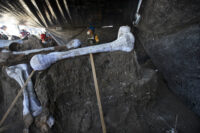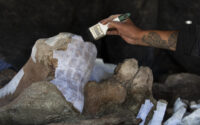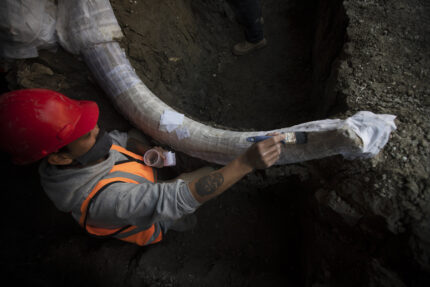 The number of remains in a mammoth graveyard discovered in Xaltocan, Mexico, has risen to 200 with no end in sight. It now officially eclipses the previous record-holder, Mammoth Site at Hot Springs South Dakota which has skeletal remains from 61 individuals, as the world’s largest site of mammoth bones.
The number of remains in a mammoth graveyard discovered in Xaltocan, Mexico, has risen to 200 with no end in sight. It now officially eclipses the previous record-holder, Mammoth Site at Hot Springs South Dakota which has skeletal remains from 61 individuals, as the world’s largest site of mammoth bones.
Skeletons from Columbian mammoths were first discovered in October 2019 during an archaeological salvage program at the site of Mexico’s City new airport, a former military base that will become the General Felipe Angeles International Airport. When the announcement of the findings were first reported in May, the team from the National Institute of Anthropology and History (INAH) had found skeletal remains of around 60 mammoths — adult male, female and juvenile — and of other Pleistocene megafauna including bison, horses and camels.
 The site was a prehistoric lake. Animals were drawn to the water and many were trapped in the marshy shore. The largest density of bones has been found at the shoreline. Animals died in deeper parts of the lake less frequently and their remains were not as well preserved as the ones who stuck in the mud.
The site was a prehistoric lake. Animals were drawn to the water and many were trapped in the marshy shore. The largest density of bones has been found at the shoreline. Animals died in deeper parts of the lake less frequently and their remains were not as well preserved as the ones who stuck in the mud.
There are so many mammoths at the site of the new Santa Lucia airport that observers have to accompany each bulldozer that digs into the soil to make sure work is halted when mammoth bones are uncovered.
“We have about 200 mammoths, about 25 camels, five horses,” said archaeologist Rubén Manzanilla López of the National Institute of Anthropology and History, referring to animals that went extinct in the Americas. The site is only about 12 miles (20 kilometers) from artificial pits, essentially shallow mammoth traps, that were dug by early inhabitants to trap and kill dozens of mammoths.
Initial discoveries at the Santa Lucia site found no evidence of humans taking advantage of the natural trap to hunt big game, but recent finds indicate they may have butchered animals at the site.
While tests are still being carried out on the mammoth bones to try to find possible butchering marks, archaeologists have found dozens of mammoth-bone tools—usually shafts used to hold tools or cutting implements—like the ones in Tultepec.
“Here we have found evidence that we have the same kind of tools, but until we can do the laboratory studies to see marks of these tools or possible tools, we can’t say we have evidence that is well-founded,” Manzanilla López said.
The site is so enormous that teams have really only scratched the surface so far. The plans for construction of the new airport are still on the books with a projected completion date of 2022, but there may be delays as the archaeological work keeps going.
Mexican Army Capt. Jesus Cantoral, who oversees efforts to preserve remains at the army-led construction site, said “a large number of excavation sites” are still pending detailed study, and that observers have to accompany backhoes and bulldozers every time they break ground at a new spot.
The project is so huge, he noted, that the machines can just go work somewhere else while archaeologists study an area.
